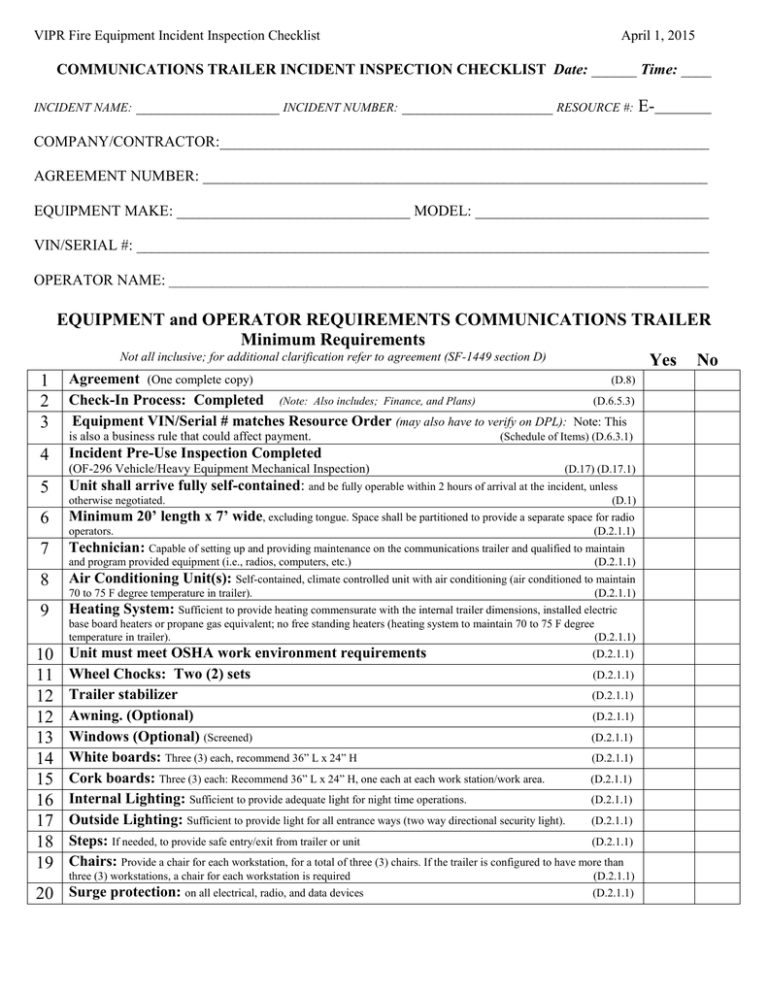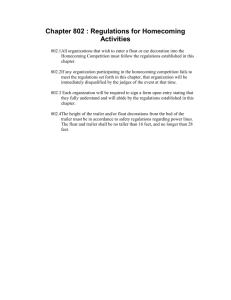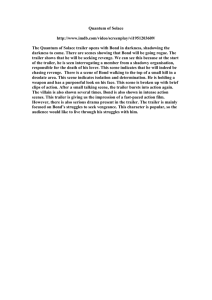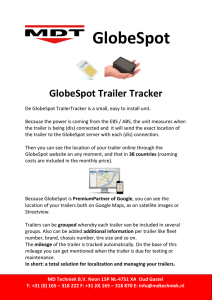E-
advertisement

VIPR Fire Equipment Incident Inspection Checklist April 1, 2015 COMMUNICATIONS TRAILER INCIDENT INSPECTION CHECKLIST Date: ______ Time: ____ INCIDENT NAME: ___________________ INCIDENT NUMBER: ____________________ RESOURCE #: E- COMPANY/CONTRACTOR:_________________________________________________________________ AGREEMENT NUMBER: ___________________________________________________________________ EQUIPMENT MAKE: _______________________________ MODEL: _______________________________ VIN/SERIAL #: ____________________________________________________________________________ OPERATOR NAME: ______________________________________________________________________________________ EQUIPMENT and OPERATOR REQUIREMENTS COMMUNICATIONS TRAILER Minimum Requirements Not all inclusive; for additional clarification refer to agreement (SF-1449 section D) Yes No 1 2 3 Agreement (One complete copy) (D.8) Check-In Process: Completed (Note: Also includes; Finance, and Plans) (D.6.5.3) Equipment VIN/Serial # matches Resource Order (may also have to verify on DPL): Note: This is also a business rule that could affect payment. 4 Incident Pre-Use Inspection Completed (OF-296 Vehicle/Heavy Equipment Mechanical Inspection) 5 (D.2.1.1) Air Conditioning Unit(s): Self-contained, climate controlled unit with air conditioning (air conditioned to maintain 70 to 75 F degree temperature in trailer). 9 (D.2.1.1) Technician: Capable of setting up and providing maintenance on the communications trailer and qualified to maintain and program provided equipment (i.e., radios, computers, etc.) 8 (D.1) Minimum 20’ length x 7’ wide, excluding tongue. Space shall be partitioned to provide a separate space for radio operators. 7 (D.17) (D.17.1) Unit shall arrive fully self-contained: and be fully operable within 2 hours of arrival at the incident, unless otherwise negotiated. 6 (Schedule of Items) (D.6.3.1) (D.2.1.1) Heating System: Sufficient to provide heating commensurate with the internal trailer dimensions, installed electric base board heaters or propane gas equivalent; no free standing heaters (heating system to maintain 70 to 75 F degree temperature in trailer). (D.2.1.1) 10 11 12 12 13 14 15 16 17 18 19 20 Unit must meet OSHA work environment requirements (D.2.1.1) Wheel Chocks: Two (2) sets (D.2.1.1) Trailer stabilizer (D.2.1.1) Awning. (Optional) (D.2.1.1) Windows (Optional) (Screened) (D.2.1.1) White boards: Three (3) each, recommend 36” L x 24” H (D.2.1.1) Cork boards: Three (3) each: Recommend 36” L x 24” H, one each at each work station/work area. (D.2.1.1) Internal Lighting: Sufficient to provide adequate light for night time operations. (D.2.1.1) Outside Lighting: Sufficient to provide light for all entrance ways (two way directional security light). (D.2.1.1) Steps: If needed, to provide safe entry/exit from trailer or unit (D.2.1.1) Chairs: Provide a chair for each workstation, for a total of three (3) chairs. If the trailer is configured to have more than three (3) workstations, a chair for each workstation is required (D.2.1.1) Surge protection: on all electrical, radio, and data devices (D.2.1.1) VIPR Fire Equipment Incident Inspection Checklist April 1, 2015 Minimum Requirements (continued) 21 Workstations: Three (3) each desktop/countertop workstations, or work area large enough to accommodate three radio operator stations with chairs. The min. individual desk top work space provided shall be 18” deep by 36” long, for each work station, [three (3) total]. Wired for phone with headsets at each workstation; wired into a labeled punch box mounted outside. 22 Electrical Power requirements (D.2.1.3) 1. Minimum 120 Volt, 50 Amp AC service entrance with disconnect switch to master breaker AC 4-plex 2. 3. 4. 5. receptacles at all dispatch stations and work stations. Electrical Breaker:No more than two (2), 4-plex outlets for each 20 amp AC service extension cable :One (1) each – 20 foot, 50 Amp AC – 3 pin Twist-Lock: Standard 3 pin adapters (20 amp service) Battery Backup: DC (battery) backup with a minimum of 200 AH capacity for initial start-up and power outages. Battery shall have capacity to power all radio equipment for at least one operational period (one shift). a. Battery must have a master disconnect or breaker switch. b. Battery must be physically isolated from work area for personnel safety. c. Battery must be a sealed, non-ventilating type, such as gel-cell. Charging System: DC charging system to maintain battery backup 6. 7. Auxiliary Connection: Two (2) each Auxiliary 12 volt connection power points near radio equipment 8. Power inverter: One (1) each DC to AC power inverter sufficient to operate three (3) laptop computers 9. External Generator: One (1) each AC generator kit to include one (1) generator with a minimum output capacity of 6000 Watts (6Kw), grounding rod, clamp and cable, one (1) each five (5) gallon fuel container meeting all DOT safety specifications. Generator shall not exceed 65 dB(A), Sound Pressure Level @ 7 meters. Radio and Electronic Equipment (D.2.1.4) 23 Radio Equipment: must be ready for immediate use upon arrival at the incident base facility or Incident Command Post (ICP), pending frequency programming 24 Vendor provided: a. b. All radio frequency programming software and any necessary programming hardware Interface devices or personal computers required by the specific manufacturer make and model of radio equipment provided within the trailer unit 25 VHF-FM P25 Digital Base Station: consisting of a minimum of one (1) VHF-FM mobile radio(s). Each radio will have a desk mic or handheld mic with a speaker providing sufficient adjustable volume to be heard in a noisy working environment. Programming instructions for user and computer programming will be available. Each radio will conform to the following requirements: a. A P25 Digital VHF-FM two-way mobile radio: with a matched broadband antenna (Antenna Specialists ASPR7490, Maxrad MWB5803, or equivalent). The radio shall provide selection of analog wideband (25.0 kHz),analog narrowband (12.5 kHz), and P25 Digital narrowband (12.5 kHz), channel spacing on each channel operating from 138 MHz to 174 MHz. The radio shall be frequencysynthesized, equipped with a CTCSS sub-audible tone encoder having a minimum of 32 selectable tones meeting the current TIA/EIA-603 standard, and develop a minimum of 30 watts nominal putput power. b. Transceivers: Set to operate in the narrowband mode unless local requirements dictate otherwise. All radios must have the ability to be programmed in the field by the radio operator without the aid of a computer or the services typically found in a radio shop. c. All P25 digital radios: Operating with current software as shown on The only exception is more up-todate software versions as released by the manufacturer. 26 UHF-FM Base Station: A minimum of one (1) UHF-FM mobile radio(s). The radio will operate from 406 to 420 MHz (minimum), have the capability for 10 (minimum) preset channels, provide a nominal power output of at least 30 watts minimum, and be user programmable without the need of a computer (although computer programming capability is also a requirement). Each radio will have a desk mic or handheld mic with a speaker providing sufficient adjustable volume to be heard in a noisy working environment. Programming instructions for user and computer programming will be available. 27 DC Power to Radio Equipment: Provided by at least one (1) each 12 Volt power supply with an automatic backup switch or relay and have a minimum capacity of 35 Amps 28 Base Station Antennas: a. VHF-FM – Broadband antenna (Antenna Specialists ASPR7490, Maxrad MWB5803, or equivalent). Note: Antennas supplied with new radios do not meet these requirements. b. UHF – Broadband antenna tuned to the proper frequency band for each required base station radio. c. At least two (2) magnetic mounted antennas with an 8 foot (minimum) RF cable for both the VHFFM and UHF-FM frequency bands are required. d. Antennas may be mounted on masts or mounted directly to the trailer. Antennas will be placed as far apart from each other as possible for frequency separation. Antennas may be detached from the trailer for transport. Yes No VIPR Fire Equipment Incident Inspection Checklist April 1, 2015 Minimum Requirements (continued) Yes No 29 RF Cables: RF cable terminations will be accessible from both inside and outside the trailer. VHF cables shall be terminated with ‘UHF’ connectors. UHF cables shall be terminated with ‘N’ connectors. A selection of interseries adapters will be provided. All cables will be permanently labeled. In addition to the base station RF cables, there shall be an additional VHF cable from each work position to an outside jack box. All cables shall be RG-213, RG-8, or better cable. 30 Telephone/Internet Service/Access (D.2.1.5) One (1) each telephone service/customer entrance panel: Accommodate a minimum of seven (7) prewired telephone jacks (RJ-11 all wired back to the RJ-66 surge protected punch down block, prewired telephone jacks installed as follows: a. one (1) for each workstation, so a total of three (3) b. two (2) external phone jacks mounted to the outside of the trailer c. two (2) additional jacks located elsewhere in the trailer d. seven (7) pre-wired internet ports (RJ-45), mounted either next to or adjacent to the seven (7) prewired telephone jacks. 31 Three (3) each telephone handsets: (One near each work station or work area). 32 LAN system (not wireless): Capable of providing service to each workstation. a. b. c. Cat 6 (or better) ran to each workstation shall terminate at a patch panel located inside the trailer for easy connection to a powered switch (i.e., LAN system) Two (2) Cat 6 (or better) runs from the patch panel to two (2) RJ-45 connections in the entry panel. c. Power over Ethernet switch with a minimum 8 port data switch. Optional 33 Internet Capability: (to establish a minimum level of service for satellite internet access and is for government use only). a. Minimum bandwidth: 1.5Mbps Download speed, 768kbps Upload speed Wireless router with port address translation and DHCP capability for internal IP address assignment. b. The ability to support for 3DES IPSec tunneling is required to support end to end solutions where remote access is needed. c. Minimum Hardware: WI-FI Access Points: 802.11 b/g/n with WPA key encryption options. d. Browser administrated. e. Power over Ethernet capable. f. POE 8 port data switch. g. Contention ratio maximum 15-1. 34 Additional Equipment (D.2.1.6) All in one fax, copier, scanner, printer: With two (2) reams of paper appropriate for the machine, for initial start up. In addition to the consumables that come with that equipment at time of dispatch, one (1) additional set of consumables (i.e., toner, ink, or other supplies necessary to keep the all in one operable) is required. Equipment meets agreement specifications Equipment does not meet agreement specifications Inspector: Date: (Print and sign) Contractor: Date: (Print and sign) Contractor given the opportunity to correct noted deficiencies (See Remarks) Contactor successfully corrected noted deficiencies Inspector: Date: REMARKS:__________________________________________________________________________________ _____________________________________________________________________________________________ _____________________________________________________________________________________________ _____________________________________________________________________________________________ _____________________________________________________________________________________________ _____________________________________________________________________________________________




